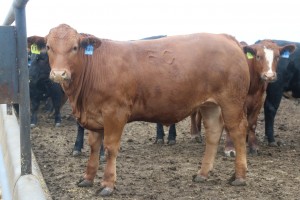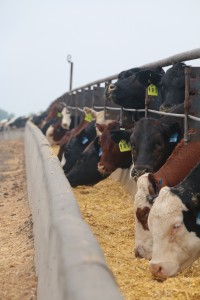Beefmaster Value Added Feeder Cattle
Profitability comes in different packages. Beefmaster has long been noted for their maternal excellence. On the cow side, Beefmaster females set the industry standard for fertility, longevity, functionality and efficiency. What many ranchers don’t realize is that Beefmasters also excel in the feedyard and on the rail.
In the past 15 years there has been a strong tendency for the U.S., beef industry to focus strictly on one trait, and that is marbling. Admittedly, we had a lot of carcass improvements to make in order to meet the consumer’s demand for high quality beef. Thank goodness the entire beef industry has been working to improve carcass quality over the past several years. Our reward is the re-emergence of beef as the consumer’s first choice in protein.
As the beef industry has focused on marbling, other traits that impact profitability have not had the same attention and selection pressure applied to them at the same extent as carcass traits. Beefmasters are rapidly gaining attention from cattle feeders and buyers for their ability to hit these often overlooked, but very valuable production targets.
Several Beefmaster breeders have quietly began to retain ownership on their straight and crossbred Beefmaster steers to discover exactly how Beefmasters perform in the yard and in the plant. The data collected over the years is eye opening.
James and Mary Ann Skelton began feeding their Beefmaster sired/influenced steers with Irsik and Doll Feedyard of Garden City, Kansas in 2010. Initially, the Skelton’s tried retaining ownership to avoid discounts at the sale barn. Once they began, they quickly discovered the advantages that Beefmasters bring to the table.
“The first thing we noticed is that our Beefmaster sired steers are very healthy. While we do have a good vaccination program at the farm and we background our calves, we have very little sickness on our steers while they are in the yard,†Skelton said.
No one, especially Skelton, is surprised by this. The strength of an animal’s immune system is impacted by heterosis. The first step to profitability in the feedyard is keeping them alive and healthy so they can perform. Beefmasters excel in this area.
Beefmasters have an immune system advantage because of their genetic makeup which is a combination of Hereford, Shorthorn and Bos indicus (Brahman influence). Adding clout over and above crossbreeding using only Bos taurus (British and Continental breeds), Bos indicus cattle have an even greater hybrid vigor effect because of the principle of genetic diversity. The more unrelated parents are, the greater the heterosis or crossbreeding effect. Beefmasters are unique in that they carry more retained heterosis than any of the other American breeds. Beefmaster sires used on Angus cows yield a “just right†blend of Bos indicus influence.
“One of the first things we noticed about our Beefmaster steers was their performance and feed efficiency,†Skelton said. “Our first pen of steers gained a 3.7 and converted on a dry matter basis at 5.15. From there we had a couple of pens of steers gain and convert pretty close to that, but our best pen gained a 4.0 and converted at 4.81.â€
To date the Skelton steers are averaging 3.6 average daily gain rate (ADG) with a 5.11 dry matter conversion rate. Anyone who has ever fed cattle can tell you that those kind of performance and conversion figures are truly special.
Spotlighting that profitability can come from areas other than carcass quality and the last set of Skelton steers closed out in December 2015 with remarkable figures. Skelton compared the November 2015 national average to his steers and arrived at the following conclusion.
“Our steers gained 3.8 and the national average was 2.8. Our steers converted on a dry matter basis at 5.5 versus the national average of 6.1. Finally the cost of gain on our Beefmasters was 65 cents versus 92 cents,†Skelton said.
Good solid performance coupled with true efficiency always positions a set of steers for profit.
The manager of Irsik and Doll Feedyard in Garden City, Kansas, Mark Sebranek, has fed some of the very best cattle of almost every breed in a wide variety of progeny tests, including Beefmasters. Sebranek’s retained ownership customers are demanding. Over the years Irsik and Doll Feedyard has developed a devoted clientele that appreciates his knowledge of cattle feeding and grid marketing. Sebranek has had several positive experiences with feeding Beefmaster influenced cattle.
“Live performance on the Beefmaster steers is good. They consistently gain in the high threes to low fours on an ADG basis, right where they need to be. Conversions on the Beefmasters are really good with some of the better pens converting in the high 4 lbs., of feed to a pound of gain, with low fives being pretty common. These ADGs, conversions and really good cattle health make feeding Beefmasters easy,†said Sebranek.
Tom Jones of Hi Plains Feeders in Montezuma, Kansas has had similar experiences with Beefmaster steers that come through their yard. According to Jones, Beefmaster steers typically convert on a feed to gain basis in the top 30%, with conversions in the upper 5 lb., range not being uncommon.
“Beefmasters are very healthy, as a matter of fact we pencil in a three-quarter percentage death loss (very low) when running breakevens. They gain well, convert well and we are not afraid to sell them on a grid,†said Jones.
In regards to grid marketing steers, Beefmaster breeders are serious about improving carcass quality. From 1998 to 2003, Beefmaster Breeders United (BBU) in cooperation with Texas A&M University conducted an extensive progeny test utilizing 15 Beefmaster sires on commercial Angus cows from the Texas A&M Research Station in McGregor, Texas. At the time, no one probably realized how relevant the Beefmaster x Angus crossbred mating would be 14 years later. To no one’s surprise, the
cattle produced carcass data by today’s standards.
Will Beefmaster sired steers hang up acceptable carcasses? Absolutely. Beefmaster sired calves out of the commercial Angus cows from the McGregor, Texas station posted impressive numbers. Seventy-two percent of the cattle produced carcasses that were USDA Prime or USDA Choice. Forty-nine percent of the carcasses earned an impressive Yield Grade 1 or 2. Given this kind of knowledge, you can confidently sell your Beefmaster influenced steers on the right grid. Given how much Beefmaster and Angus carcasses have improved since the progeny test referenced above, one could reasonably assume that the carcass traits of today’s Beefmaster x Angus crossbreds will be even better in the plant.
While everyone is emphasizing quality and yield grades as the focal point for carcass traits, Beefmasters offer a counterbalance trait that can help equalize the quality grade difference. Hot yields or dressing percentages on Beefmaster sired cattle are impressive, handily exceeding plant averages. James and Mary Ann Skelton have been seeing impressive hot yields on their steers averaging over 65% with one harvest group coming in at 65.74%.
Mark Sebranek points out that “even though we are selling these cattle on a grid, at the end of the day we are still selling pounds. Pounds of carcass that is. You can have cattle that light up a grid, but if they are below plant average on dressing percentage, you will be discounted. That’s what I like about the Beefmasters I have fed. They have enough quality grade to keep them marketable and their hot yields mean more carcass weight to sell. It’s an important thing to remember.†
Today’s cattleman has a lot to consider. Given the rapid improvements in carcass quality the industry has seen over the past decade, it could be argued that as an industry we have injected a tremendous amount of marbling into America’s cow herd, and that is a good thing. If we know the cattle will work in the plant, is it not time to refocus our efforts on building functional, fertile and efficient cow herds?
Now, more than at any time in our history, the American commercial cow herd will receive the biggest returns at almost every sector by simply crossbreeding and letting heterosis add value to the industry. The selling points of crossbreeding are that more calves are born, healthier calves are born, more pounds of pay weight are produced, and cows have longer, more productive lives. Beefmasters are uniquely qualified to add that all important heterosis punch. The impressive performance, conversion, health and economic traits seen by James and Mary Ann Skelton can be achieved by almost any progressive cattleman.
True, heterosis influences all of the profitability traits but that is the point Beefmaster breeders are trying to make. Heterosis works and Beefmasters used on high percentage Angus cows yield the crucial balance of maximum production, acceptable carcass and just enough “ear†influence. Beefmaster bulls used on Angus cows result in a calf crop that is 75% British and 25% Bos indicus. This percentage of Brahman influence is optimum for performance and the carcass still has enough punch to add significant value to your replacement females. If you have kept back continental heifers as replacements, you will be amazed at how productive Beefmaster sired females out of these cows will be.
Remember, profitability comes in different packages. Beefmaster genetics will help you take advantage of the inherent efficiencies many ranchers have been overlooking. Beefmasters produce truly superior females with healthier, higher performing and higher yielding steers that will definitely keep you profitable.









